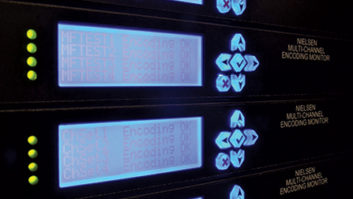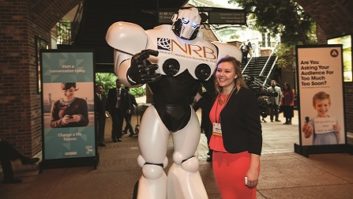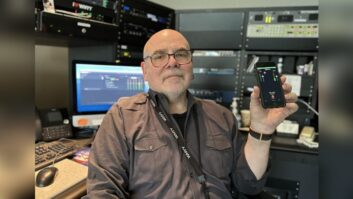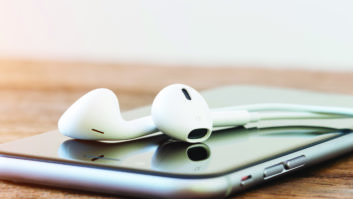Since its origins in 2004, podcasting has come from a leading-edge concept to part of the general media landscape. But opinions still vary widely on its current and future importance.
Looking back, there’s one thing that most agree upon, and which this column predicted in the March 16, 2005 issue: The early fascination with podcasts by amateurs has largely given way to the pros, with most audio podcasts today originating from within the traditional radio content industry.
There is good reason for this, but also significant doubt as to whether or how much positive benefit flows to the radio industry as a result. Let’s consider both of these factors.
RaDio TiVo
There are several real advantages to podcasts for radio.
(click thumbnail)The site Podcasting Station helps visitors find podcast content — here, programming from KPBS.First, the content already is produced for broadcast in most cases (that’s how these podcasts become popular, since most users have first become aware of the programs over the air), so there is little extra work required.
Thus offering podcasts of existing radio programs maximizes the utility of their production cost by providing an alternate platform by which listeners can access the shows.
Second, podcasting’s use of syndication (i.e., subscription) makes them easier to access than some other alternate platforms like standard downloads or Internet radio.
For podcasts, the listener only needs to perform an online access task once, and future episodes of a repeating program series continue to simply show up on their PCs and handhelds until the listener tells them to stop.
Third, podcasts are inherently portable for most users, because they usually are synced automatically between the PC on which they are initially captured and any associated handheld device(s). The latter in turn can be easily set to play into any (non-PC) audio system in the home or office, connected via wire or wireless to automotive sound systems, or used for personal listening via headphones.
So unlike Internet radio, podcasts already reach almost every place that broadcast radio does — plus a few that it doesn’t (like the underground portions of a listener’s commute, for example).
Consider also that, like all online media, podcasts are inherently personalized, and they allow the listener to select the content, and then pause, rewind and fast-forward it while listening — none of which is yet offered by regular radio, of course. Finally, podcasts often include some textual or graphical metadata, and some even offer segmentation for improved navigation within a long-form program (e.g., moving between songs in a music show, or between stories in a news magazine).
With all these additional attributes, there’s a lot to like for listeners who have a favorite radio show that they don’t want to ever miss. Besides giving them confidence that they will always catch the program, they don’t have to make an appointment to do so, and they can play it when their schedule permits (stopping and starting as necessary), or hear it multiple times if they want to. They can also burn it to CD, send it to others or add it to a playlist with other podcasts or songs from their library to program their own radio-like stream (a common application of podcasts by commuters).
Since there still is no widely available DVR-like product for radio, podcasts provide the next best thing.
Pod wars
Nevertheless, recent data shows that podcast listening is still a fringe phenomenon, and has not yet broken through to widespread or mainstream usage.
A recent Pew report shows that fewer than one in five Americans has ever downloaded a podcast, and fewer than one in five of those users receives one on any given day.
Although these numbers have grown by about 60 percent since a similar study conducted in 2006, respected radio industry analysts like Mark Ramsey and Kurt Hanson remain unimpressed. Hanson feels that podcasting has not lived up to its hype, while Ramsey labels it still a niche element.
Others feel differently, however. A panel at the NAB Radio Show extolled the virtues of podcasting, claiming that it can generate measurable new revenue for the industry. A few success stories on podcast sponsorship and voluntary listener contributions do already exist, mostly within the public radio sector.
There are also those who feel that, like wireless Internet radio, podcasting is yet another way to feed radio content to younger audiences who don’t listen much to broadcast radio. In their view, it’s therefore too early to tell what the ultimate impact of podcasting will be.
Then there’s the compared-to-what analysis, by which those 1-in-5 podcast numbers look pretty good in contrast to HD Radio penetration to date.
But podcasting’s value is perhaps most suspect when it comes to scrutiny of its business model.
Because a downloaded podcast may never actually be listened to, yet each download costs the broadcaster some bandwidth expense, the podcast delivery model could be characterized as “we-pay-you-to-(possibly)-listen,” which is a far cry from the traditional broadcast approach.
New audience measurement technology eventually could improve on the uncertainty-of-listening issue, but overall podcasting’s net business impact likely will remain relatively small for some time.
Perhaps the best way for radio broadcasters to use podcasts today is to promote them as a value-add to their most motivated audience sectors, providing a “premium listening experience” (i.e., personalized, interactive, etc.) for their favorite shows. In this respect, podcasts can also be a brand-strengthener for broadcasters, on both the national and local levels.
So for now, podcasting remains but one viable arrow in the broadcaster’s growing quiver. Only time will tell how far it flies, and if its aim is true.













